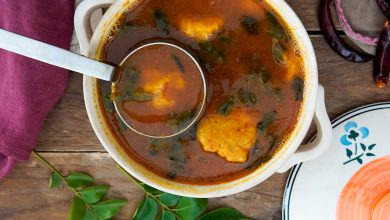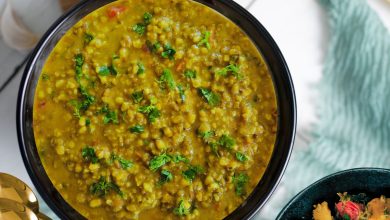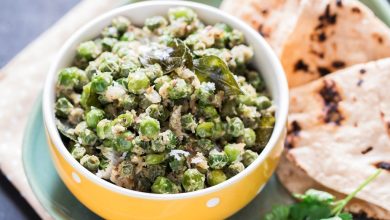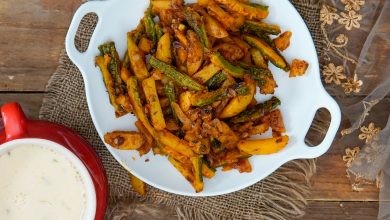Soft Homemade Idiyappam – Easy Rice Noodles Recipe
Homemade Idiyappam Recipe (Rice Sevai) – How to Make It from Scratch
Idiyappam, also known as Rice Sevai or String Hoppers, is a popular traditional South Indian breakfast delicacy, made from rice flour and shaped into delicate noodles. These light, soft rice noodles pair wonderfully with a variety of flavorful side dishes, like Vegetable Korma or Kerala Style Vegetable Stew with Coconut Milk. Making homemade Idiyappam might seem labor-intensive, but once you master the process, it’s a rewarding dish to prepare for your family or guests.
Below, we’ll guide you through the step-by-step process of making this delicious homemade Idiyappam recipe. Whether you’re serving it as part of a South Indian breakfast or for a light dinner, this recipe will walk you through the traditional way of preparing this beloved dish.
Ingredients for Homemade Idiyappam (Rice Sevai)
| Ingredients | Quantity |
|---|---|
| Rice | 2 cups |
| Water | For soaking & grinding |
| Salt | To taste |
Preparation and Cooking Time
| Prep Time | Cook Time | Total Time | Servings |
|---|---|---|---|
| 120 minutes | 30 minutes | 150 minutes | 4 servings |
Step-by-Step Instructions
1. Soaking and Grinding the Rice
To begin making the Homemade Idiyappam recipe, the first step is to prepare the rice batter. Follow these steps:
-
Soak the rice: Take 2 cups of rice and wash it thoroughly. Then, immerse the rice in enough water to completely cover it. Let the rice soak for about 2 hours. This soaking process helps soften the rice and makes it easier to grind.
-
Grind to a smooth paste: After soaking, drain the rice and transfer it to a mixer grinder. Gradually add a little water and grind the rice into a smooth, thick paste. Ensure that the batter has a semi-thick pouring consistency, but it should not be too runny. If the batter is too thick, the Idiyappam will become tough, and if it’s too thin, it won’t hold its shape.
2. Steaming the Rice Dumplings (Idlis)
-
Prepare the idli molds: Grease the idli molds with a little oil to prevent sticking. This will make it easier to remove the steamed rice dumplings later.
-
Steam the rice batter: Pour the prepared rice batter into the greased idli molds. Place the molds in a steamer and steam the idlis for about 10 minutes, or until they are fully cooked. These steamed rice cakes will form the base for the noodles.
3. Making the Sevai (Rice Noodles)
-
Prepare the sevai maker: Once the idlis are steamed and ready, it’s time to press them into noodles using a sevai maker, also known as Sevai Nazhi. This traditional tool helps create soft, delicate noodles.
-
Press the idlis while they are hot: One of the most important tips for making perfect Idiyappam is pressing the idlis while they are still hot. If the idlis cool down, they will become firm and difficult to press. Carefully place one hot idli into the sevai maker, and begin pressing to form soft rice noodles. Turn the wheels of the sevai maker slowly and continuously, allowing the noodles to fall into a large bowl. Repeat this process for each steamed idli.
-
Repeat the process: Continue pressing all the idlis until you have prepared noodles from all of them. The key is to work quickly, while the idlis are still hot, to achieve the perfect texture.
4. Serving the Homemade Idiyappam
-
Fluff and serve: Once all the noodles have been made, gently fluff them with a fork or your hands to separate them. Homemade Idiyappam is now ready to serve!
-
Pair with accompaniments: Idiyappam is typically served with flavorful side dishes like Mixed Vegetable Korma or Kerala Style Vegetable Stew with Coconut Milk. The mild taste of the rice noodles makes them a perfect base for absorbing the rich, spiced flavors of these curries. You can also drizzle some coconut oil or sprinkle grated coconut over the Idiyappam for a simple, yet delicious, meal.
Tips for Perfect Idiyappam
- Temperature matters: Always press the steamed rice idlis while they are hot. If they turn cold, the noodles will be tough, and it will be challenging to form them.
- Grinding consistency: Make sure the rice batter is smooth but not too runny. A semi-thick consistency is essential for soft, well-formed noodles.
- Sevai maker: The traditional Sevai Nazhi is the best tool to use for pressing the noodles, but if you don’t have one, a similar noodle press or murukku maker can be used as a substitute.
Nutritional Information (per serving)
| Nutrient | Amount (Approx.) |
|---|---|
| Calories | 180 kcal |
| Carbohydrates | 38 g |
| Protein | 4 g |
| Fat | 0.5 g |
| Fiber | 1 g |
| Sodium | Varies (based on salt added) |
| Potassium | 55 mg |
Variations of Idiyappam
-
Sweet Coconut Idiyappam: For a sweet twist, you can add grated coconut and jaggery to the cooked Idiyappam. Mix them well and serve with a drizzle of ghee.
-
Lemon Sevai: Another popular variation is to temper the Idiyappam with mustard seeds, curry leaves, green chilies, and lemon juice for a tangy, flavorful version known as Lemon Sevai.
-
Tomato Sevai: Sauté tomatoes, onions, garlic, and spices to create a tomato-based sauce and toss the noodles in it for a savory meal.
Perfect Pairings for Idiyappam
Idiyappam’s light and fluffy texture makes it an ideal base for soaking up the bold flavors of South Indian curries and stews. Here are a few popular side dishes that complement Idiyappam:
-
Mixed Vegetable Korma: A mildly spiced curry made with a medley of vegetables and a creamy coconut-based sauce. Its rich flavors perfectly contrast the soft, neutral taste of Idiyappam.
-
Kerala Style Vegetable Stew with Coconut Milk: This hearty stew, packed with vegetables and simmered in coconut milk, offers a comforting and flavorful accompaniment to Idiyappam.
-
Coconut Chutney: A simple, fresh coconut chutney made with grated coconut, green chilies, and curry leaves provides a cooling side to enjoy with your noodles.
-
Sambar: A tangy, spicy lentil-based vegetable stew, typically served with rice, is also a fantastic side for Idiyappam.
Idiyappam is not only a traditional South Indian breakfast but also a versatile dish that can be adapted with various flavors and accompaniments. Whether you prefer it with sweet coconut, tangy lemon, or a rich, creamy curry, this homemade Idiyappam recipe is sure to bring the authentic taste of South Indian cuisine to your table. Once you master the technique, it will become a go-to meal for special occasions or weekend breakfasts.
Enjoy the simplicity and taste of these delicate rice noodles, and don’t hesitate to explore different flavor variations and accompaniments. From classic curries to chutneys, Idiyappam offers endless possibilities!








